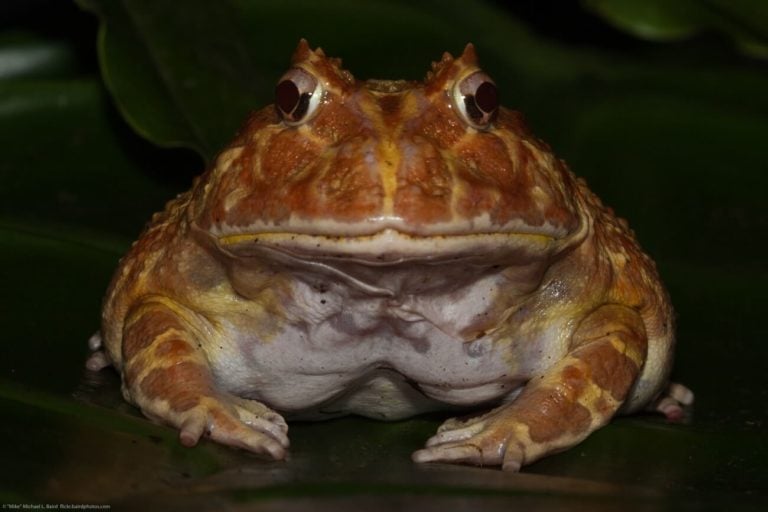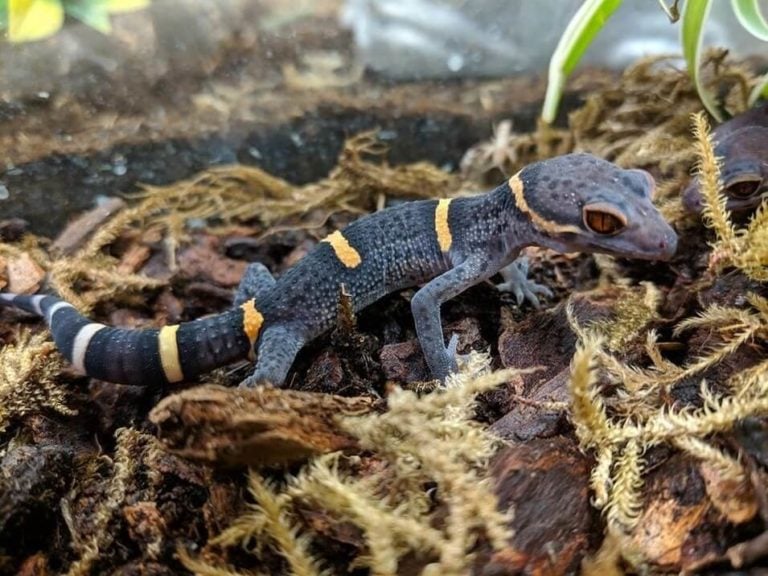Reeve’s turtles are a lively and fun reptile to own. With their high level of activity and low-maintenance care requirements, these creatures are a great beginner-friendly introduction to keeping pet turtles.
However, there are still some unique conditions you’ll need to provide if you want this species to thrive. Being hardy doesn’t mean you can be totally hands-off!
This guide digs into all the facts you need to know when it comes to Reeve’s turtle care. You’ll learn about their habitat and tank setup, diet, size, lifespan, and more!
Table of Contents
Species Summary
The Reeve’s turtle (Mauremys reevesii) is an easy-going reptile that’s a joy to watch. The semi-aquatic species is very active and spends time on land and in the water.
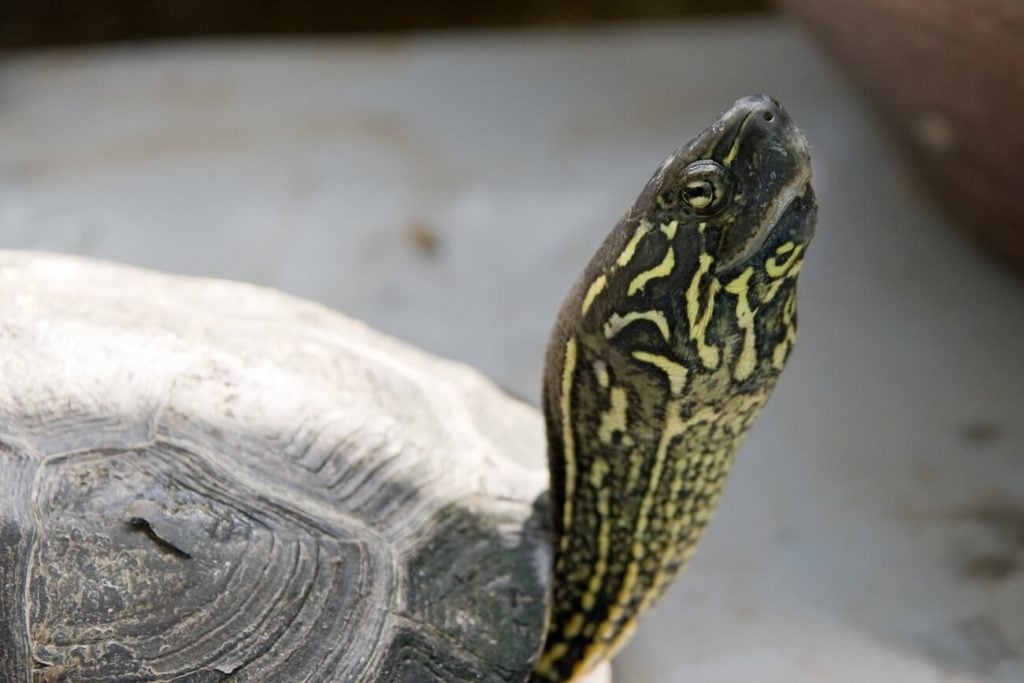
While not the most colorful turtle out there, these pint-sized creatures certainly make cute pets that even novice reptile-owners can care for.
The distribution of the Reeve’s turtle in the wild is quite vast. They’re often seen living in ponds and slow-moving streams throughout China, Japan, North Korea, South Korea, and Thailand. However, they’re also known to migrate to unique environments like marshes and rice paddies.
There are several morphological forms of the Mauremys reevesii. These forms have varying physical features based on the region they come from. However, they all have the same needs when it comes to care.
Average Reeve’s Turtle Size
The average Reeve’s turtle size is around nine inches in length. However, the potential full size will vary based on what kind you have.
On the smaller end of the scale, you have forms that are about four and a half inches long! Most of the critters born in captivity are going to reach an average length of about six inches.
Expert Tip: Reeve’s turtles are the smallest member of the Mauremys genus. The turtles are quite small compared to other species in the reptile trade.
Lifespan
With proper care, you can expect the lifespan of a Reeve’s turtle to be between 10 and 15 years. They are capable of living a bit longer on occasion, with this species reportedly reaching the 20 year mark from time to time (however, those instances are quite rare).
Ultimately, the life expectancy of these turtles is impossible to know for sure. Many factors will determine a turtle’s overall health and vitality.
That said, you can do your part to improve the chances of your turtle living a long life. High-quality care can help you avoid potential diseases that will shorten their lifespan.
Appearance & Colors
From an appearance standpoint, Reeve’s turtles are relatively plain. Beyond their size, this turtle species don’t have too many signature traits.
The carapace is usually dark in color, features shades of brown, olive green, and black. There aren’t any distinct patterns, either. The only identifying feature is three longitudinal keels.
The plastron features the same basic coloration. It’s usually cream-colored or tan. You might notice some smudges of black or dark brown as well.
Generally, the shell of this turtle is rectangular shaped. It features more length than significant width.
Expert Tip: Females are a bit larger in size than males. They also have a flat or slightly convex plastron. Meanwhile, males have a concave plastron with a longer and thicker tail.
Reeve’s Turtle Care
When compared to other popular turtle species, the Reeve’s turtle care is pretty to manage (no matter how much experience you have). Thanks to their small size, they don’t require massive enclosures and they’re easy to please when it comes to decor.
That said, these turtles do need an optimal environment in order to live long and healthy lives. They also have some specific needs in the dietary department!
Here are some care guidelines to follow:
Tank Size
Let’s start with the enclosure. Because Reeve’s turtles require both land and water, you will need a tank-like enclosure. Standard aquariums as well as high-walled vivariums work fine.
For a single turtle, we recommend a tank that’s at least 24 inches long by 12 inches tall. Larger is always better though, so it’s good to get a tank that fits your space while still respecting the minimum size.
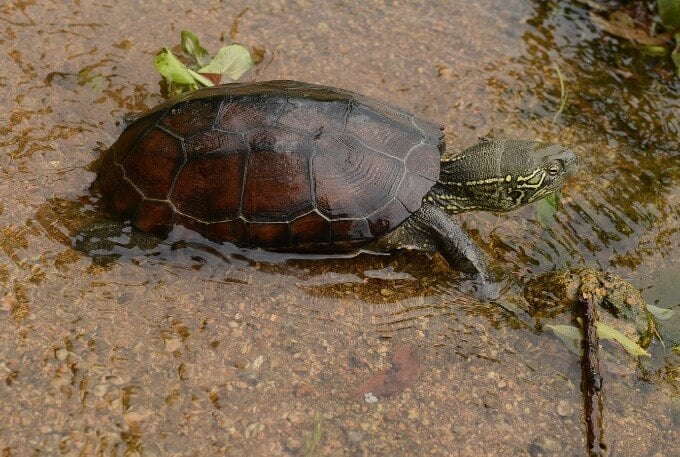
One of the most important aspects of the enclosure setup is going to be water depth. The enclosure needs to be partially filled to a depth based on your turtle’s size.
The water depth should be no less than 1.5 times the length of your turtle. Generally, owners aim for three times the length of the turtle to be on the safe side.
Reeve’s turtles aren’t the strongest swimmers, so you don’t need deep waters. However, the water portion should be deep enough to prevent the turtle from getting stuck upside down and drowning.
As a good rule of thumb, a single baby turtle needs about five gallons of water volume. If you plan to keep multiple turtles, add about two to three gallons of volume for each one. For adults, you’ll need 20 gallons for a single turtle and an additional 10 gallons for each one thereafter.
Expert Tip: Keep in mind, the water volume doesn’t reflect the overall volume of the tank since these reptiles need both water and land in their enclosure.
Habitat & Tank Setup
Reeve’s turtles need some spots to bask on dry land. You can create a natural shoreline using a substrate. However, floating perches are usually easier to work with.
Just make sure that the land is large enough to support the entire turtle. It should also have enough room for your pet to turn around.
Some underwater shelter is good to have in their tank setup too. You can use plastic decorations or fake caves. Artificial plants work well, too.
These turtles are notorious for shredding live plants, so it’s best to avoid them.
For substrate, use fine sand or large rocks. The key is to choose a material that’s either small enough to pass through safely or large enough to prevent your turtle from eating it.
A strong filtration system is a must. These turtles do produce a lot of waste, so you’ll need to ensure that the filtration system can handle their biological load and keep the water safe for them to swim in.
Temperature & Lighting
Your turtle’s enclosure will have three separate temperature zones. These are:
- The water
- The ambient air
- The basking spot.
Use a basking lamp to create a hot area over the land perch. It should reach temperatures of 85 to 95 degrees Fahrenheit. Some turtles may prefer slightly higher temperatures of 100 degrees.
On the opposite side of the enclosure, ambient air temperatures should be around 75 to 85 degrees.
Finally, the water should be around 70 to 80 degrees.
Creating these three zones let your Reeve’s turtle thermoregulate as needed. If you don’t provide them with the appropriate zones and temperature their health will quickly go downhill.
Expert Tip: You can also add a UV lamp. The UV lamp will provide UVB rays to help synthesize calcium. It’s not always necessary if your turtle is consuming calcium supplements (more on that later). However, it doesn’t hurt to use one if you want to play it safe.
Humidity
The humidity levels for a Reeve’s turtle needs to be quite high. You’ll want to aim for 70 to 90 percent.
While this might seem high at first (especially compared to other types of pet reptiles), it’s pretty easy to achieve in a semi-aquatic environment. This is because the presence of water naturally helps facilitate a high level of humidity without constant effort on your part.
Regardless, use a hygrometer to monitor levels and adjust air circulation accordingly if the percentage climbs too much.
Water
Your turtle will get all the hydration they need from the water portion of their enclosure. There’s no need for a separate water source in their enclosure.
This means it’s crucial for you to monitor their water conditions closely. Test for ammonia and nitrates regularly and keep your filtration system in good condition.
You should also perform partial water changes every week to ensure that the water conditions are safe and comfortable. This process will keep the water clean and reduce the likelihood of your Reeve’s turtle getting sick.
Food & Diet
Reeve’s turtles are omnivores and are not picky when it comes to food.
Commercial turtle food is usually the best way to go. Look for a nutritionally balanced diet that covers all of their needs.
Expert Tip: This food should be about 30 to 40 percent protein, low in fat, and high in Vitamin D.
Most importantly, the food must have a calcium to phosphorus ratio of 2:1. Those nutrients are paramount for good health. Without it, your turtle could suffer from metabolic bone disease.
You can provide some snacks to supplement commercial food. Reeve’s turtles enjoy insects like mealworms, crickets, locusts, and cockroaches. Just make sure that the insects are gut-loaded and dusted with calcium powder.
Leafy greens like water lettuce, duckweed, and water hyacinth are much-appreciated as well. These will provide them with some additional vitamins and nutrients, as well as some much-needed variety to their diet.
Potential Health Issues
The Reeve’s turtle is quite a hardy species. Because most of the specimens you see in the trade are bred in captivity, your risks of parasites are low, too.
However, Reeve’s turtles can still encounter problems from a poorly maintained environment or lackluster diet.
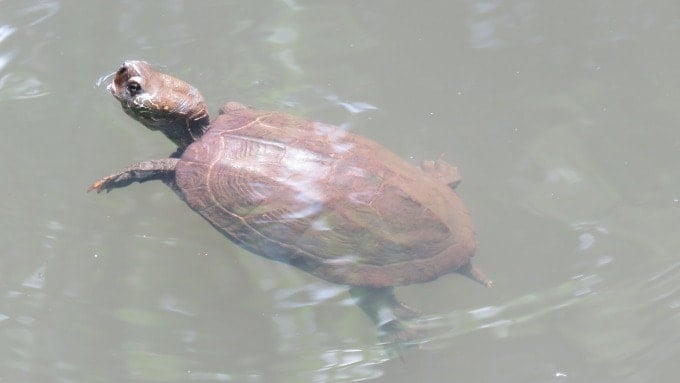
Shell rot is a particularly nasty disease you want to avoid. Caused by bacterial and fungal infections, the disease can cause pitting on the carapace. In severe cases, it can even lead to cracks. The disease can progress so much that the bacteria penetrates deep into the body.
Metabolic bone disease is another thing to be wary of. When turtles don’t get calcium or have exposure to UVB rays, their bones can get weak and brittle. This is especially troublesome for turtles because of their shell.
Fortunately, both of these diseases are avoidable. Keep your tank in good shape and clean it out regularly. Also, provide your turtle with a calcium-rich diet and give them access to UV light for good measure.
Behavior & Temperament
Reeve’s turtles aren’t the most social animals out there. However, they can live with others of their own kind.
You might encounter some light aggression and territorial skirmishes every once in a while, but those fights rarely result in injury. If you’re worried about in-fighting, invest in a larger enclosure with enough space for each turtle to call their own.
This species is quite active (which makes them a great pet to spectate). This is especially true once they get into the water.
While not powerful swimmers, they do love to explore underneath the surface of the water. Once they’re done, you can usually find them relaxing under the basking light!
Handling Them
Like most species in their family, Reeve’s turtles don’t enjoy being handled. They’ll tolerate it when necessary, but you should never hold them for more than a few minutes.
Excess handling will only lead to stress and potential injury. The turtle can become agitated and start to scratch or even bite you.
In general, reserve handling to times when you need to perform maintenance on the tank. Be gentle and put them in another safe spot quickly. As always, don’t forget to wash your hands thoroughly after handling!
Conclusion
We highly recommend this species to anyone who wants a pet turtle without a bunch of hassle. Reeve’s turtle care is very beginner-friendly, and doesn’t require much to get started.
And watching these reptiles swim around is a blast! These are definitely one of the most entertaining turtles you can own.
Go ahead and give them a shot! You won’t regret it.

